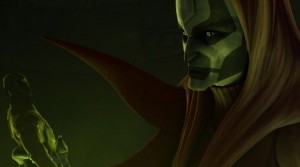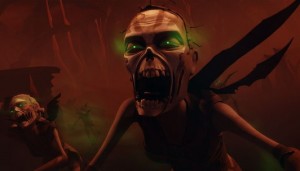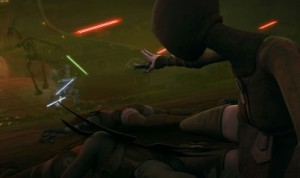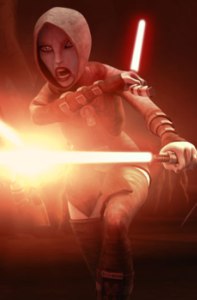“Massacre” is a unique episode. Almost shockingly violent and creepy, it focused entirely on the Nightsister clan. In a season filled with big battles, “Massacre” ups the ante by being almost one continuous scene of warfare, with occasional asides to Dooku or Grievous. There is comparatively little dialogue, although one thing that hasn’t changed from the movies is the lingering shots on the droid deployment that someone, somewhere must find riveting. The majority of the characters are female, and the majority of the characters are unlikeable. New magics are introduced, with the Nightsisters able to raise an army of undead. Introducing a lot of new elements at the beginning of an arc makes for a very exciting episode, but also left me feeling a bit uncertain about where that arc is going to go.
The epigraph says, “One must let go of the past to hold on to the future.” Presumably the past that must be let go is the history Asajj Ventress has with the Nightsisters. The episode focuses on them and is visually and thematically dark from the beginning. The first ten minutes also have the most telling dialogue. In a few lines of conversation we learn that both Asajj and Mother Talzin see the Sith and the Nightsisters as completely different entities; to have loyalty to both of them is to be split in two. Both Talzin and Asajj know that Asajj will not be happy being “a true Nightsister,” and the fact that Asajj feels that she is destined for something else – Sith, Jedi, or a goal she herself doesn’t know – makes me feel for her. Throughout The Clone Wars we’ve seen a lot of Asajj angst, so it was enjoyable to get hints at where some of it comes from. This episode was not intended for heartfelt talks, though. Asajj says, “I have nothing,” and thereby agrees to officially join the sorority of the Nightsisters out of desperation. But she’s still not happy with it.
Next comes one of the aforementioned asides to Grievous, who stalks around in fine Grievous fashion. I felt a little thrill at the prospect of him joining the battle, because suddenly it’s possible a scenario heretofore only found in fan material might actually come true: Grievous could fight Darth Maul.
Here’s a secret: I’m primarily concerned with Darth Maul. Ever since Savage’s face appeared out of the dark gray floor in a chalk drawing at Celebration V two Augusts ago, Filoni has been teasing that Darth Maul was coming to The Clone Wars. It makes sense to coincide his return with the 3D release of The Phantom Menace. Maul was my favorite character when I first saw Episode I. Charmed by Ray Park’s grace and the implied determination and patience behind Maul’s villainy, I thought he was a unique character, both subtle and grotesque at the same time. Most fans agree that he was given short shrift. But it’s not quite time for his appearance on television just yet. I can’t judge “Massacre” based solely on the fact that there wasn’t a single mention of Darth Maul – but I do have to get it out of the way. If he is the major face of the arc’s marketing, it would have been nice to have a mention to whet the fan’s appetites. Maybe there’s a framing device somewhere in “Massacre” that will be revealed later, but for now, I feel like this episode was a branch off of a central timeline instead of a critical event on that timeline.
Asajj might disagree. Her induction into the Nightsisters is clearly a big deal for her. The sisters’ hazing ritual is creepy and ties in well with what we’ve previously seen of their power. The green fog gets a lot of mileage in this episode, and clashes dramatically with the red haze that was shown in Grievous’ space scenes to be apparently covering the entire planet. Asajj sinks into the ground and re-emerges. She doesn’t receive a dramatic physical change like Savage.
 When the battle begins, Mother Talzin uses some pretty cool new powers to produce green Force lighting and an equally sickly green Glinda bubble. She has stated that Asajj’s knowledge of technology will help the witches, who have their magic but are sheltered from the rest of the galaxy. Asajj, though, doesn’t pass that knowledge on. She brings her lightsabers to bear along with the witches’ purple bows and destroys some droids and tanks.
When the battle begins, Mother Talzin uses some pretty cool new powers to produce green Force lighting and an equally sickly green Glinda bubble. She has stated that Asajj’s knowledge of technology will help the witches, who have their magic but are sheltered from the rest of the galaxy. Asajj, though, doesn’t pass that knowledge on. She brings her lightsabers to bear along with the witches’ purple bows and destroys some droids and tanks.
I didn’t like the introduction of one Nightsister, Karis, by name simply so she could get killed off later. Karis did appear last season, but not with a personality attached. Her presence here reminded me of Ahsoka’s friend Kalifa in last year’s season finale, whose importance to the more central character immediately signaled her death. I’m not sure whether the way it also reminds me of the Ewok mourning his dead companion in Return of the Jedi makes the scene more affecting or just unintentionally funny.
It’s telling that Talzin turns to something other than technology when she’s really besieged. She scampers away to a hidden cave to introduce yet another new element: a wizened woman who is the oldest of the Nightsisters. I was initially a bit disappointed by yet another new element being added instead of an existing one expanded, but the matriarch’s character design, with her big headdress, was pretty unique, and as soon as she began her “chant of resurrection” I knew that this could explain the return of Darth Maul.
Before Maul comes back, though, we were treated to Star Wars with zombies.
I don’t have either a negative or positive gut reaction to zombies. What’s more interesting to me is how they’re used, and in “Massacre” I feel like they’re a dark twist on the mechanical versus organic theme that Star Wars often uses. I said before that the Nightsister battle reminded me of the Empire versus Ewoks fight in that it presents a technological society pitted against a natural one. We also saw the eco-friendly slant when the primitive Gungans defeat the Trade Federation in The Phantom Menace or Grievous’ CIS forces in The Clone Wars’ “Shadow Warrior.” In “Massacre,” although the lines are clearly drawn, the most repellant act of war is to make organic life continue to be organic life after its expiration date.
 The Nightsister zombies are really remarkably disgusting, with green eyes trailing smog and a couple shots focused on distended, broken jaws. They originate from vampiric upside down pods. Either it’s normal Nightsister protocol to be commemorated by hanging upside down from a tree, or these bodies have been kept in case of emergency. Their origin is like a mix of Voodoo lore and vampiric legend, and for me, its introduction into Star Wars was very shocking.
The Nightsister zombies are really remarkably disgusting, with green eyes trailing smog and a couple shots focused on distended, broken jaws. They originate from vampiric upside down pods. Either it’s normal Nightsister protocol to be commemorated by hanging upside down from a tree, or these bodies have been kept in case of emergency. Their origin is like a mix of Voodoo lore and vampiric legend, and for me, its introduction into Star Wars was very shocking.
However, it wasn’t shocking in a way that knocked me out of the fictional dream. We’ve already got the Son and Daughter, Red Harvest zombies, werewolf-like rakghouls, and the Force itself. Compared to these, zombies aren’t especially unusual. We even saw more unexplained but also misty magic from the Gungan sorcerer in “Shadow Warrior.” But the undead – and especially that specific term being uttered in the episode – did prompt me to agree when a friend said that this episode pushed Star Wars straight over the line from science fiction into science fantasy. That’s not a problem. It was simply made more obvious in this episode. (And I might have preferred a term other than “undead,” with its wealth of contemporary pop culture associations.)
After the zombies, the episode just gets scarier. A small metal MacGuffin hides a.tiny feather duster? Nope, a voodoo doll made from Dooku’s hair. A blank-faced homunculus of the Count is produced and gives Dooku the worse acne of all time, melting the mannequin’s face like wax. Dooku being tortured at Talzin’s distant hands was a guaranteed source of wincing, as he sprouted boils and then Talzin seemed to burst out of his chest. Definitely not the usual kids’ show fare, and if anything of these things were inflicted on Anakin or Obi-Wan it would be even more riveting. One of the striking things about this episode was that there was almost no one to root for. Asajj is pitiable but there is absolutely no feedback from the Jedi.
This episode is long and grueling, filled with action as well as match-ups we’ve seen before, although the longstanding Asajj-Grievous rivalry coming to a lightsaber-clashing close is pretty awesome. Asajj makes a deal that sounds empty: I can’t imagine Talzin and her wizened pet resurrector giving in to Grievous willingly. Grievous is, after all, not only a machine but also a man.
One cool bit of returning lore is the defoliator, the giant machine used by the droid army. Its silly name makes me think of lumberjacks every time, but I loved how pitting it against the zombies showed an aspect of it that no one had thought of before: it doesn’t work against the undead.
 The end of the episode leaves me feeling even more sorry for Asajj, although whether it’s because of my previous attachment to the character or the animators’ effective use of slumping I’m not quite sure. Asajj feels guilt for the slaughter of this clan of Nightsisters, but Talzin seems to absolve her of responsibility. Asajj sees this as abandonment, and one in a long series. She’s definitely one of the more interesting characters, and one whose difficult past explains her angry outlook.
The end of the episode leaves me feeling even more sorry for Asajj, although whether it’s because of my previous attachment to the character or the animators’ effective use of slumping I’m not quite sure. Asajj feels guilt for the slaughter of this clan of Nightsisters, but Talzin seems to absolve her of responsibility. Asajj sees this as abandonment, and one in a long series. She’s definitely one of the more interesting characters, and one whose difficult past explains her angry outlook.
In the end, this episode felt more like one long, continuous scene than a full story. Which, in fact, it was: the camera’s attention wasn’t off either Asajj or Talzin very often, and this is the opening act in a larger arc. But Asajj became a Nightsister and lost them, all in 22 minutes. It’s hard to say whether this battle would have been better longer or shorter without seeing the rest of the arc, but I mentioned before my disappointment at the fact that we’re not going to get any framing devices here. The uniqueness of the episode extends to its subject matter as a whole: it could stand alone as an Asajj character piece, entirely unrelated to Darth Maul and Savage. It looks like next week will be the same, and this still seems like a strange choice to me after all the hype.
I shouldn’t be complaining when Asajj is one of the most complicated characters on the show. However, this episode sometimes sidelined her in favor of lingering shots of droids unbolting from tanks, or zombie jaws going even more crooked than usual. It also sidelined the very existence of the Zabrak brothers, therefore leaving me mostly muddled about what it might be pointing toward. Overall, “Massacre” was technically impressive and surprising in a lot of ways but the minimal plot progression makes the episode feel like filler, and that seems hard to do when there are zombies involved.
As a standalone episode, I give “Massacre” a 6/10. It has some really cool, really scary fight choreography and impressive animation. However, I’ll have to wait until the arc ends to see whether this hefty battle scene is balanced out at the season finale or is left weighing the four episodes down on one side.
Megan Crouse is a recent college graduate with a strong interest in fandom studies and pop media. She writes This Blog Is Full of Words and has published poetry and short fiction. Other interests include martial arts, poultry, and Darth Maul.

